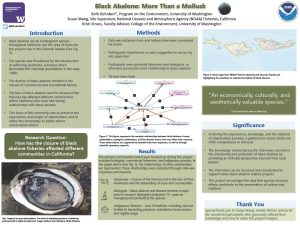Examining the Impact of Endangered Black Abalone on California Stakeholders to Inform Future Conservation Efforts
Black abalone has been listed as an endangered species since 2009 due to a disease called withering syndrome. This disease decimated the population, leading to the closure of the recreational and commercial fisheries in California. The closure of the fishery and the decline of black abalone has adversely impacted communities and the intertidal ecology of Coastal California. Black abalone are currently being monitored and protected by different organizations and agencies in the hopes of restoring their population. NOAA Fisheries is a government agency that is focused on such efforts throughout California. One way that NOAA Fisheries is improving their plans to protect black abalone, is the incorporation of Local Ecological Knowledge (LEK) to inform future management decisions. My internship at NOAA Fisheries consisted of conducting Oral History Interviews with black abalone fishermen and marine biologists in efforts to preserve their knowledge, improve management decisions, and public education. These interviews provide a very personal account of the relationships developed among different communities and black abalone. The interviews may also provide observational data about black abalone, both past and present. Overall fishermen, Indigenous people, and the intertidal ecology has suffered from the loss of black abalone. All participants expressed their concern for black abalone and the hope for a strong comeback of this species. The push for the recovery and resilience of black abalone will continue, not only for the sake of the environment, but also for the restoration of community and cultural traditions.
